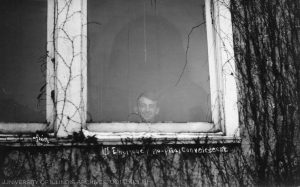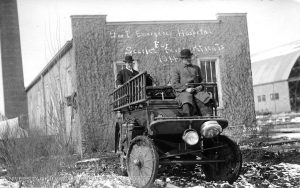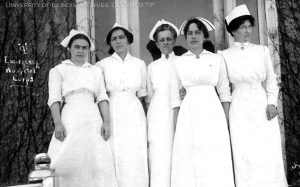
As life drastically changes for students, faculty, and staff at the University of Illinois and across the country, it may help to remember that this is not the first time that the University has faced a disruptive health crisis. Multiple outbreaks have peppered the University’s past, including the flu, smallpox, and scarlet fever. In 1914, a scarlet fever epidemic disrupted student life and spurred the University into action.
The Daily Illini reported the first student with scarlet fever in 1914 on February 10. By February 12, four more students were confined to the Burnham Hospital in Champaign. The spread of scarlet fever prompted Thomas A. Clark, the Dean of Men, to put out a statement, “In the present uncertain situation with regard to scarlet fever no one can afford to take unnecessary risk.” Clark urged sick students to see a physician, to isolate themselves until their diagnosis was confirmed, and not to attend class if they were sick. [1]
Quarantines, cancellations, and fumigation became a part of University life. Buildings, rooms, and offices across campus were fumigated and books returned to the Main Library were treated as “suspect.” Athletic and social events were cancelled as were general exercises in Military and Physical Training, along with large classes. Students who were sick or exposed to the infection were isolated and quarantined in hospitals or at home, including an entire fraternity. [2] A rather successful Illini basketball season, even called historic by the 1915 Illio, also came to a halt to avoid the spread of the disease.
In a February 27 article, the Daily Illini reported that students were refusing to hold or shake hands with even their closest friends. Some were even skipping class to avoid infection. It also noted the that the supply of Listerine and Glyco-Thymoline at drug stores were exhausted, along with playing cards and disinfectants. [3]

To confront the health crisis, a special committee of faculty was appointed. On March 10, 1914, a report from the committee was submitted to the Board of Trustees, noting the troubling situation. At the request of the committee, Dean Clark, wrote a letter to President Edmund James, outlining the actions taken in response to the epidemic.
In his letter, Clark made it clear that the University could not rely on the assistance of Champaign and Urbana. Referring to a meeting with the mayors and health officers of the cities, Clark reported, “It was quite evident from the discussion which occurred at that meeting that the cities of Champaign and Urbana had no intention of assuming any responsibility for the care of students, should any more of them fall ill.” [4]

The University had to act. Clark reported that the University created an emergency hospital out of a “small frame and stucco building,” known as the “Service House,” which sat at the east end of the parade grounds (near the present 6th Street entrance to the Gies Business Instructional Facility). The building was cleaned and outfitted with electricity, plumbing, heating, and even a borrowed “electrical cooking apparatus” from the Department of Household Sciences. The emergency hospital was staffed with doctors and nurses, who received their first patients on February 23. The hospital staff cared for sick students, providing a place for quarantine on campus, and transferring severe cases to Burnham Hospital. [5]
Throughout March and April of 1914, Daily Illini headlines announced each new case and standstill in the epidemic. At the end of April, the outbreak slowed down with the Daily Illini reporting the last students in isolation at the emergency hospital were being prepared for release. By April 30, the emergency hospital closed with its last patient transferred to Burnham Hospital.
[1] Thomas A. Clark, “To Students,” Daily Illini, February 19, 1914.
[2] Twenty-Seventh Report of the Board of Trustees of the University of Illinois (Urbana, 1914): 721.
[3] “Humorous Side Relieves Tenseness of Situation,” Daily Illini, February 27, 1914.
[4] Board of Trustees, 719.
[5] Board of Trustees, 719-721.